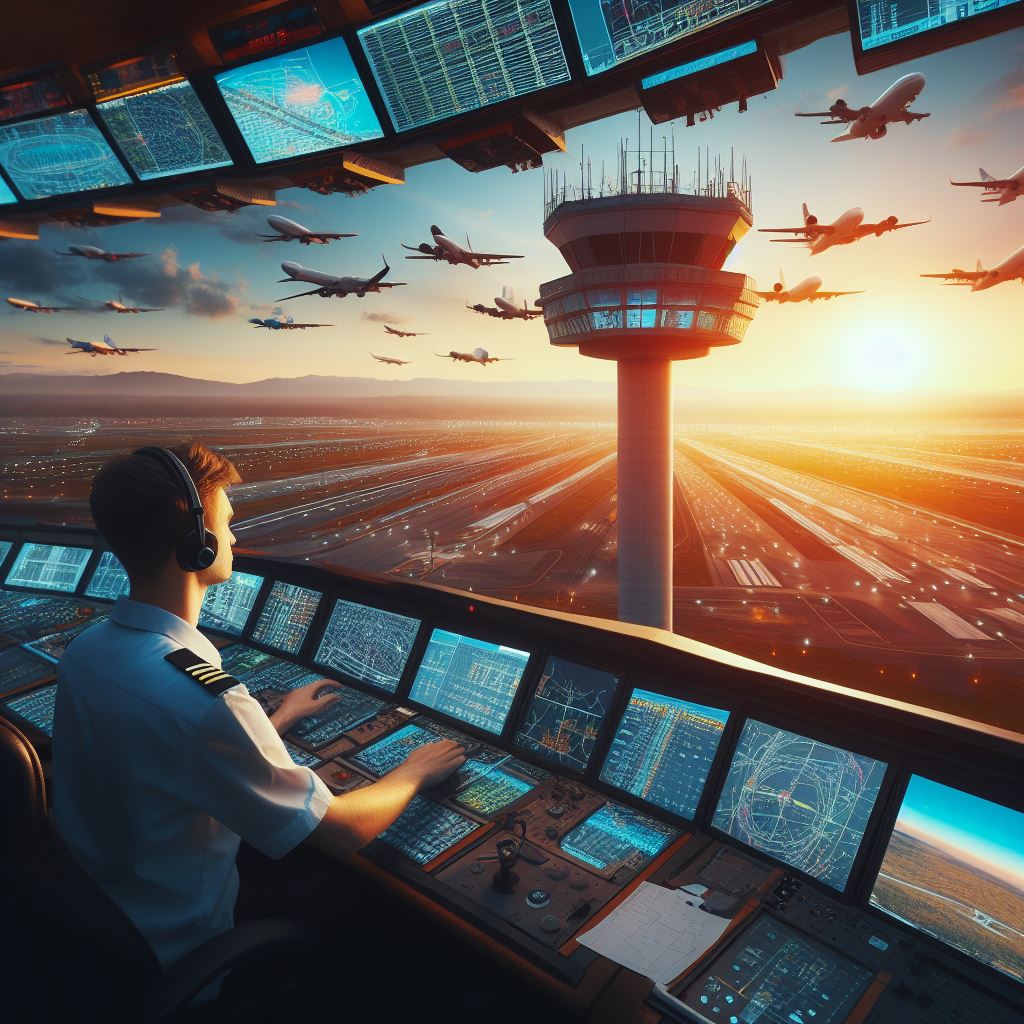Introduction
Air traffic control hubs play a critical role in managing the vast airspace in the United States.
They are central locations where air traffic controllers guide and direct aircraft, ensuring safe and efficient operations.
These hubs are of utmost importance as they facilitate the movement of millions of passengers and tons of cargo daily.
They serve as vital connectivity points that link various airports and regions, contributing to the overall functioning of the aviation industry.
With a complex network of aviation routes, air traffic control hubs ensure that flights can navigate through congested airspace, following specific flight paths and maintaining safe distances from other aircraft.
By efficiently managing the flow of air traffic, these hubs reduce the risk of accidents and delays.
Moreover, air traffic control hubs also help optimize the utilization of airspace and airport resources.
They enable airlines to operate more efficiently, improving on-time performance and minimizing fuel consumption.
This not only benefits airlines but also reduces carbon emissions and overall environmental impact.
In the United States, major air traffic control hubs like Atlanta, Chicago, and Los Angeles are particularly significant.
These hubs handle a significant proportion of the nation’s air traffic, serving as major gateways for domestic and international flights.
They contribute significantly to the economic development of the regions they serve and provide employment opportunities in the aviation industry.
In conclusion, air traffic control hubs are vital components of the aviation system, ensuring the safe and efficient movement of aircraft.
Their significance in the United States cannot be overstated, as they facilitate connectivity, enhance operational efficiency, and contribute to economic growth.
Definition and Characteristics of Air Traffic Control Hubs
In this section, we will explore the definition of air traffic control hubs and discuss their various characteristics.
Definition of Air Traffic Control Hubs
- An air traffic control hub refers to a strategic location where air traffic control services are provided.
- It serves as a central point for the management and coordination of air traffic within a specific region.
- These hubs play a crucial role in ensuring the safety, efficiency, and smooth flow of air traffic.
Characteristics of Major Air Traffic Control Hubs
Major air traffic control hubs possess certain distinct characteristics that set them apart from other airports:
Size and Capacity
- These hubs are generally large in size, capable of accommodating a significant number of aircraft.
- They have extensive runways, taxiways, and terminal facilities to handle a high volume of air traffic.
- Their capacity is measured by the number of aircraft movements they can handle in a given time period.
Number of Flights Handled
- Major air traffic control hubs handle a substantial number of flights on a daily basis.
- They serve as the primary arrival and departure points for numerous domestic and international flights.
- These hubs cater to both passenger and cargo flights, facilitating seamless travel and transportation.
Connectivity and Reach
- Air traffic control hubs are strategically located to provide optimal connectivity and reach.
- They are typically situated in areas that allow easy access to multiple destinations.
- Passengers and airlines benefit from the hub’s extensive network of routes and flight connections.
Infrastructure and Technology
- Major air traffic control hubs are equipped with state-of-the-art infrastructure and advanced technology.
- They have modern radar systems, communication networks, and navigation aids to ensure efficient operations.
- Their facilities include control towers, radar control centers, and communication control rooms.
In conclusion, air traffic control hubs are vital elements of the aviation industry.
They act as central points for managing air traffic and possess distinct characteristics such as size, capacity, connectivity, and advanced infrastructure.
These hubs play a significant role in ensuring safe and smooth air travel for both passengers and cargo across the United States.
Read: Safety Protocols & Procedures in U.S. Air Traffic Control
Transform Your Career Today
Unlock a personalized career strategy that drives real results. Get tailored advice and a roadmap designed just for you.
Start NowMajor Air Traffic Control Hubs in the U.S.
1. Albuquerque Air Route Traffic Control Center (ARTCC): Description and Statistics
The Albuquerque Air Route Traffic Control Center (ARTCC) is one of the major air traffic control hubs in the United States.
Located in Albuquerque, New Mexico, this hub offers a significant geographical advantage. It serves as a crucial link between the western and central regions of the country.
The ARTCC in Albuquerque handles a substantial number of airlines and flights. With its strategic position, it manages air traffic for prominent carriers operating in the region.
The airport facilities and services provided by the Albuquerque ARTCC are of top-notch quality. They ensure efficient operations and contribute to the overall safety and convenience of passengers and airline personnel.
The economic impact of the Albuquerque ARTCC on the region is substantial. It generates employment opportunities and attracts businesses related to the aviation industry.
2. Anchorage ARTCC: Description and Statistics
The Anchorage Air Route Traffic Control Center (ARTCC) is another notable air traffic control hub in the United States.
Located in Anchorage, Alaska, this hub offers unique geographical advantages due to its proximity to the Arctic region and its strategic location on the route between Asia and North America.
The Anchorage ARTCC handles a significant volume of airlines and flights, particularly those traveling between Asia and North America.
It plays a crucial role in ensuring safe and efficient air travel in this important transpacific corridor.
Similar to other major ARTCCs, the Anchorage hub provides excellent airport facilities and services, catering to the needs of airlines, passengers, and other stakeholders involved in air travel.
The economic impact of the Anchorage ARTCC on the region is substantial as well. It contributes to the local economy by creating jobs and supporting various businesses related to aviation and transportation.
3. Atlanta ARTCC: Description and Statistics
The Atlanta Air Route Traffic Control Center (ARTCC) is one of the busiest air traffic control hubs in the United States.
Located in Hampton, Georgia, this hub enjoys a strategic geographical advantage due to its proximity to Hartsfield-Jackson Atlanta International Airport, one of the busiest airports in the world.
The Atlanta ARTCC manages a significant number of airlines and flights, primarily serving the southeastern region of the United States.
It handles a substantial portion of the air traffic in this densely populated and economically active area.
The airport facilities and services provided by the Atlanta ARTCC are top-notch. They ensure smooth operations and contribute to the overall efficiency and safety of air travel in the region.
The economic impact of the Atlanta ARTCC on the region is immense. It supports the local economy by creating jobs, attracting aviation-related businesses, and facilitating trade and tourism.
These major air traffic control hubs, including the Albuquerque ARTCC, the Anchorage ARTCC, and the Atlanta ARTCC, play a crucial role in ensuring safe, efficient, and reliable air travel in the United States.
Their strategic locations, airline handling capabilities, excellent airport facilities, and positive economic impacts contribute significantly to the overall aviation industry in their respective regions.
Showcase Your Business Today
Reach thousands of readers actively exploring professional services. Publish your business profile and grow your audience now.
Publish NowRead: The Impact of Technology on Air Traffic Control in the USA

Significance of Air Traffic Control Hubs in the U.S.
In the United States, air traffic control hubs play a crucial role in connecting major cities and regions across the country.
These hubs act as central points for airline operations and provide essential services for the aviation industry.
1. Role in connecting major cities and regions across the country
Air traffic control hubs serve as vital transportation gateways, linking major cities and regions. They facilitate efficient movement of people and goods, enabling seamless connectivity across the nation.
These hubs ensure that air travel remains a convenient and accessible mode of transportation.
By strategically locating these hubs in key geographic locations, airlines can offer numerous flight options and schedules, allowing passengers to reach their destinations quickly and conveniently.
This web of connectivity helps meet the travel demands of millions of passengers every year.
2. Support of the national economy
Air traffic control hubs contribute significantly to the national economy by fostering economic growth and development.
The aviation industry, directly and indirectly, supports millions of jobs and generates substantial revenue.
These hubs serve as economic engines for the regions they are located in, attracting businesses and creating employment opportunities.
The presence of efficient air transportation infrastructure enhances the overall competitiveness and productivity of the U.S. economy.
3. Contribution to tourism and travel industry
Air traffic control hubs play a crucial role in facilitating travel and tourism.
They provide essential services to handle the increasing number of domestic and international tourists visiting various destinations in the United States.
By offering a wide range of flight options, these hubs make it easier for travelers to explore different cities and attractions.
The convenience of connecting flights enables tourists to explore multiple destinations within a single trip, boosting the tourism industry and promoting economic activity.
4. Facilitation of international and domestic flights
Air traffic control hubs in the U.S. ensure smooth operations of both international and domestic flights.
They serve as key points of entry for international travelers and cargo, efficiently managing customs and immigration processes.
By coordinating flight schedules and supporting interline agreements between airlines, these hubs enable seamless connections between international and domestic flights.
Passengers can easily transfer from one airline to another, enhancing travel options and increasing connectivity.
5. Enhancing trade and commerce
Air traffic control hubs are instrumental in facilitating trade and commerce within the United States and with other countries.
These hubs serve as important gateways for the transportation of goods and enable efficient supply chain management.
By connecting major trading centers and providing reliable cargo transportation services, these hubs support the movement of products and contribute to the growth of import/export activities.
They help businesses reach global markets effectively, fostering economic exchange and driving trade.
In fact, air traffic control hubs in the United States play a crucial role in connecting major cities and regions, supporting the national economy, facilitating tourism, managing international and domestic flights, and enhancing trade and commerce.
These hubs are vital for the efficient functioning of the aviation industry and contribute significantly to the overall development and connectivity of the country.
Read: Challenges & Rewards of Being an Air Traffic Controller in the U.S.
Challenges and Future of Air Traffic Control Hubs
In addition to their significance, air traffic control hubs also face several challenges in the present era.
Current challenges faced by air traffic control hubs
- Increasing air traffic volume leads to congestion and delays in busy airports.
- Outdated infrastructure and equipment hinder efficient operations.
- Staff shortages and the need for skilled personnel pose a challenge.
- Security threats and the need for enhanced safety measures.
Technological advancements and modernization efforts
To tackle challenges, air traffic control hubs are embracing technological advancements and modernization strategies.
- Implementation of NextGen systems for improved communication, navigation, and surveillance.
- Automation and artificial intelligence to enhance efficiency and accuracy.
- Data-driven decision making using advanced analytics and predictive tools.
- Collaboration with industry partners to develop innovative solutions.
Environmental concerns and sustainability
As air traffic continues to grow, environmental concerns and sustainability have become important factors for air traffic control hubs.
- Efforts to reduce carbon emissions and mitigate the environmental impact of aviation.
- Promotion of sustainable aviation fuels and adoption of greener technologies.
- Implementation of noise reduction measures to minimize the impact on surrounding communities.
Integration of unmanned aerial vehicles (drones)
The rise of unmanned aerial vehicles (drones) introduces new challenges and opportunities for air traffic control hubs.
- Developing regulations and procedures to ensure safe integration of drones into airspace.
- Implementing systems to detect and manage drone operations near airports.
- Collaborating with drone manufacturers and operators to establish guidelines and standards.
Potential growth and future developments
Despite challenges, air traffic control hubs have significant growth potential and exciting future developments.
- Expansion of existing hubs and construction of new ones to accommodate increasing demand.
- Integration of advanced technologies like artificial intelligence and blockchain for improved operations.
- Innovation in air traffic management systems to enhance safety and efficiency.
- Exploration of new concepts such as urban air mobility and supersonic travel.
In conclusion, air traffic control hubs face various challenges but are adapting to the evolving aviation landscape through technological advancements, environmental sustainability efforts, and integration of drones.
With potential for growth and exciting future developments, these hubs continue to play a crucial role in managing air traffic and ensuring safe and efficient operations.
Read: Salary & Benefits Overview: Air Traffic Controllers in the USA
Conclusion
In conclusion, major air traffic control hubs play a vital role in the U.S. aviation industry.
They facilitate the safe and efficient flow of air traffic, ensuring smooth operations and avoiding congestion.
These hubs are strategically located in key cities, connecting various domestic and international destinations.
By acting as central control centers, they coordinate the movements of thousands of flights every day.
Furthermore, these hubs support the growth of the aviation sector in terms of economic development and job opportunities.
It is crucial for readers to appreciate and support these significant infrastructures.
Showcase Your Business Today
Reach thousands of readers actively exploring professional services. Publish your business profile and grow your audience now.
Publish NowWithout them, the air travel experience would be chaotic and dangerous.
Thus, individuals should advocate for investment in modernization and expansion of these hubs.
By doing so, they contribute to the development of a robust and reliable aviation network.
In conclusion, air traffic control hubs are the backbone of the U.S. aviation industry.
They play a significant role in ensuring the safety, efficiency, and growth of air travel in the country.
Understanding their importance and supporting their development is essential for a thriving aviation sector.
[E-Books for Sale]
The Big Book of 500 High-Paying Jobs in America: Unlock Your Earning Potential
$19.99 • 500 High-Paying Jobs • 330 pages
Explore 500 high-paying jobs in America and learn how to boost your career, earn more, and achieve success!
See All 500 High-Paying Jobs of this E-Book
1001 Professions Without a Degree: High-Paying American Jobs You Can Start Now
$19.99 • 1001 Professions Without a Degree • 174 pages
Discover 1001 high-paying jobs without a degree! Unlock career tips, skills, and success strategies for just $19.99!




